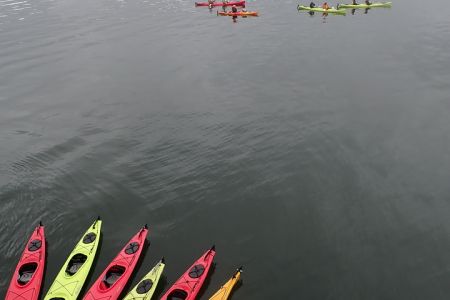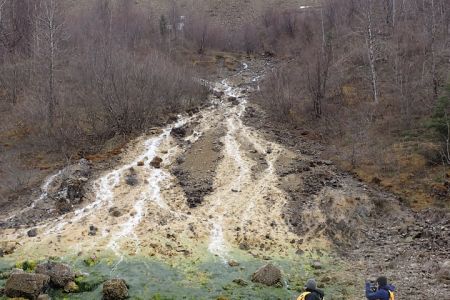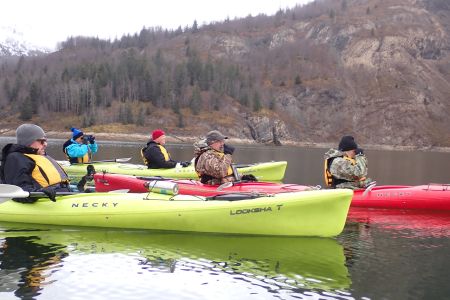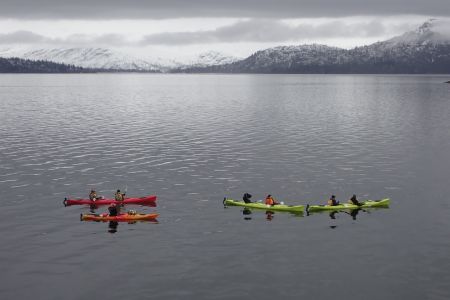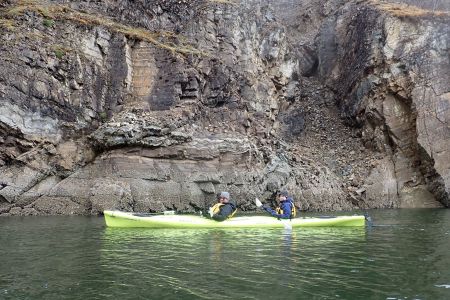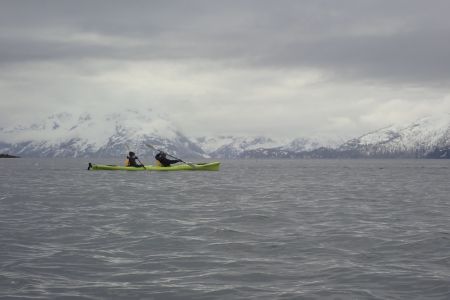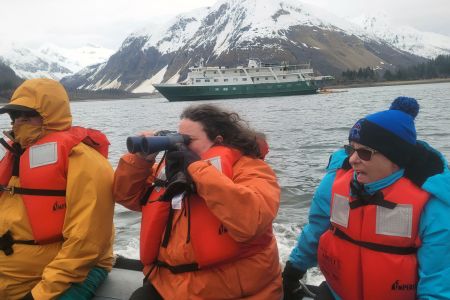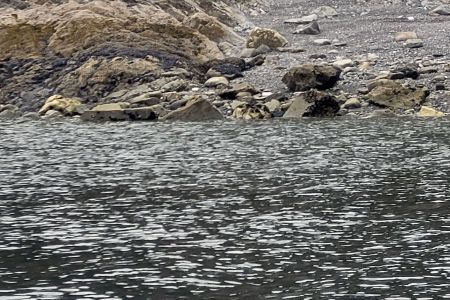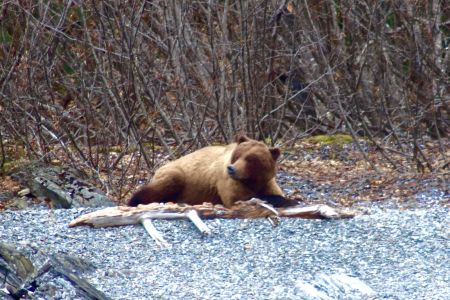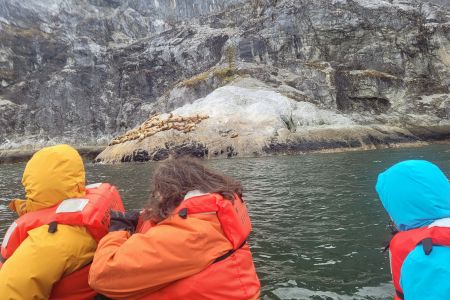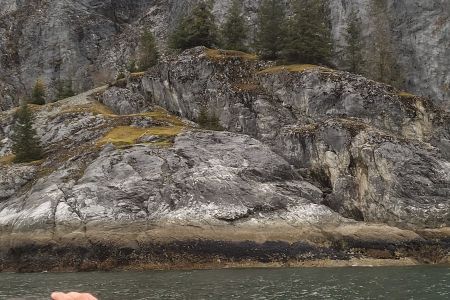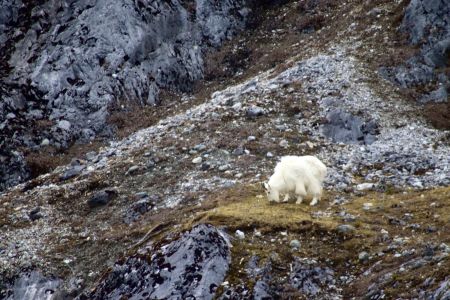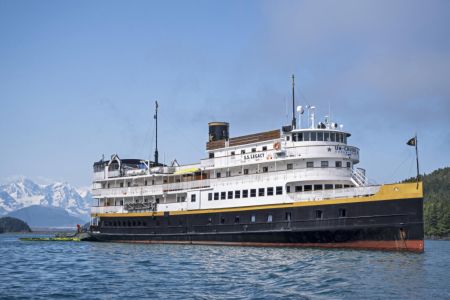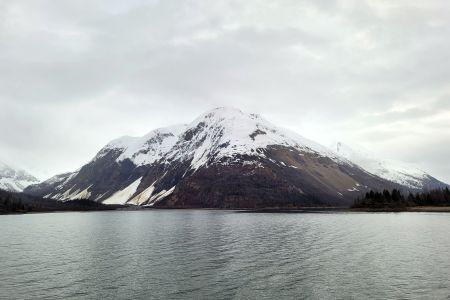
Day 5 (Friday):
“So this is Glacier Bay”
We awake for our first of two days in Glacier Bay National Park. The boat is still motoring into Tidal Inlet, a small arm off in the northeastern-most portion of the park, but as we make our way out into the lounge, we can see the crew readying to drop anchor. Apparently the fjords in the park carved by the later glaciers are so deep and fall off so quickly that there are only a few points where the bottom is within reach of the anchor line of a boat as small as ours, so aligning the anchor drop takes some precision. But soon the chain is released, causing the entire boat to echo in a loud rumble.
The weather is a bit white and overcast, but the water is calm and the snow-covered peaks of the surrounding mountains are awe inspiring. Now that we’re anchored, and the crew come back inside, attention is turned to scanning the shoreline. Britany runs into the lounge to tell us she’s spotted a brown bear on the near beach, and everyone grabs their binoculars to head out to the foredeck. Sure enough, the bear is rummaging along the rocks, likely looking for a decent breakfast. It’s massive, and not in any particular hurry, staying at the shore for a good 40 minutes or more.
When 7:00 rolls around, we’re back on Aft 300 doing our morning stretches with Kelsie, staring out at the glassy sea and white cliffs around us. Then it’s back down to the breakfast buffet. Brittany joins us in the dining room to go over today’s ops: for the morning, there will be guided kayaking into a small cut of the inlet, a shorewalk, or a skiff tour around the bay; for the afternoon, it’s more guided kayaking, or a skiff tour. We contemplate the options, and sign up for the kayaking in the morning, and since we hadn’t taken a skiff tour yet, decide that’s a good choice for the afternoon.
So it’s off to our cabin to suit up and put on our kayaking PFDs, then back out to Aft 300 to meet up with Erin who will lead us out in the kayaks. Joining us this morning are Dave and Margy, and Reed and Karen. Erin calls down to the fantail, and the EZ Dock is ready for us, so we head down, climb into our boats, and the deckhands slide us out into the softly rolling water.
Kayak means "man-boat" in Eskimo
The waves are definitely lighter than the last time we were in a kayak, and the fog has started to lift. Rowing is slow and easy, as Erin guides us into the small inlet. A small otter follows us as we paddle, then disappears under the surface, presumably to find it’s breakfast. We scan the high, steep cliffs for mountain goats, but the cloud cover is still too low to see the tops. The echos of raptor screeches bounce off the walls of the cut so clearly that it’s almost impossible to tell which direction the calls are actually coming from.
Our kayaking prowess has improved quite a bit; partly because the rudder seems to be properly adjusted for Margaret, and partly because we just seem to be better coordinated in general. We follow Erin down one side of the cut, as she tells us about what the otters might be finding along the bottom, about the different birds that swoop across the surface, and about the fish that swim somewhere in the middle.
After close to an hour, we strike a long slow u-turn at the end of the inlet and head back in the other direction along the opposite shore. Waterfalls are beginning to thaw, and one in particular catches our eye due to the stunning, almost fluorescent green algae growing at it’s base. As we get nearer to the last of the small points in this portion of the inlet, and closer to the Wilderness Explorer, we see another bear walking along the berm above the shore. Erin thinks it might be the same bear as this morning, but he scrambles back into the brush before we get close.
Slowly returning to the ship, we line up with the rollers and the deckhands haul us onboard. Then it’s back to our cabin to strip off a layer or two, and out to the lounge to compare adventures with our friends and wait for lunch. We’re told that the morning skiff tour saw yet another bear. They are definitely making their presence known in the bay.
Bears and Bears and Bears, oh my!
There are eight of us in the skiff for the afternoon tour, not including James the driver, and Kelsie, who rides at the front of the boat. The wind has picked up just a bit from the morning, so the ride is bumpy and exhilarating, but James promises to slow down if anybody wants to take pictures.
We’re not 100 yards from the boat when we, too, spot a bear chilling out on the beach. Despite what most of us have learned, bears, and in particular Alaskan Brown Bears (aka Grizzlies) do not fully hibernate. Instead, they enter a state called “torpor”, which is much lighter than true hibernation; they will awake quite often during the winter. Kelsie tells us that this bear is looking to be still groggy from torpor, and is just camping out on the beach to try to catch some sun and warmth. It glances our direction, but then goes right back to it’s stupor. James throttles down considerably as we approach, so as not to disturb, and we drift a bit closer. It’s amazing, and somewhat comforting, just how disinterested this bear is in us.
As we’d been shown in one of the crew presentations earlier in the week, Black Bears are not always black, and Brown Bears are not always brown (go figure). You can really only identify this particular bear, from this distance at least, by the distinct hump it has at it’s front shoulders.
Everyone takes a good long look through their binoculars, we all get the photos we want, and the James quietly steers away and toward a point to the west ominously called Gloomy Knob.
As we round Gloomy Knob, the entire stony rockface beyond is covered in dozens of Sea Lions, barking their displeasure at having the skiff disturb their afternoon siesta. Despite some being nearly as big as the bear just around the corner, they are definitely more concerned as we ride by. They rush right up to the edge of the rocks, to make their point, but they are either too lazy, or too confident that we don’t really present a threat, to actually jump into the water. All bark and no bite is the Sea Lion.
Continuing on, we move out to more open sea and choppier water. We spot quite a number of mountain goats, scaling the rocky cliffs, and James again slows for pictures. Finding mountain goats amongst the black and white cliffs is an interesting experience. They are masters of climbing, and of camouflage. You could be staring at a particular spot on the mountain for some time, and then suddenly realize you’re staring directly at a goat. Some are standing on crags that could be no wider than a few inches. Some are scaling the shear faces of the mountain, jumping up or down several feet as casually as humans walk on a sidewalk. They seem fearless, and experienced. They have, of course, moved to the cliffs to avoid interactions with bears, but it must be a exhausting existence having to practice such gymnastics every day of their lives. It's also striking how little vegetation is hugging the cliffs. A lone brush here, a bit of grass there. And yet the mountain goats seem to be able to get to all of it and somehow survive.
James throttles up and we go a bit further up the coast, before we spot another ship in the distance. It happens to be a sister ship in the Uncruise fleet, the Wilderness Legacy. Slightly bigger than the Explorer, and built to resemble an old-time riverboat, she spends half of her year in Alaska and half running the Columbia and Snake rivers back home. She’s apparently returning from a day at Lamplugh Glacier further north. James slows down so as not to disturb her passengers.
As we continue on with not another Sea Lion or Mountain Goat to be seen, we decide it’s time to head back. We grab ahold tight of the safety lines on the skiff, and James opens the throttle to spin us around and point us toward the Wilderness Explorer. We say goodbye to the Sea Lions as we pass by them once more – they seem quite a bit less perturbed than they had before; perhaps they recognized us, or perhaps they were just wallowing after a particularly big meal – and then a quick fly by to check on the bear again – he’s still there, in pretty much the same position he’d been in. With the ship finally in sight, and set against the backdrop of the beautiful inlet, we pause for each of us to pose for pictures at the front of the skiff. Then we pull alongside, and we climb back onboard.
The skiff ride was wet and cold, and we’re glad to be back in our cabin peeling the layers off and then out to the lounge to drink something warm and to tell everyone of our sightings that afternoon.

